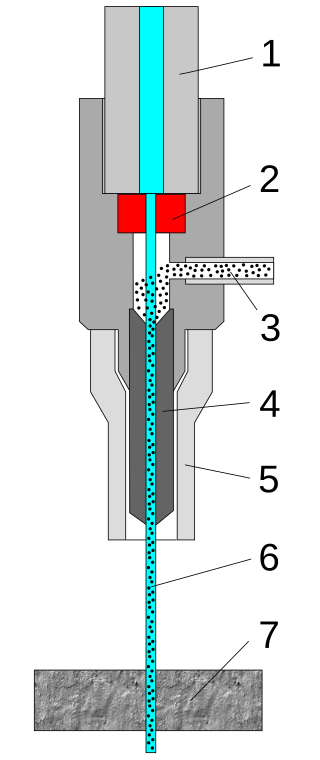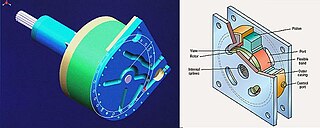
Excavators are heavy construction equipment primarily consisting of a boom, dipper, bucket and cab on a rotating platform known as the "house" - although the largest form ever, the dragline excavator, eliminated the dipper in favor of a line and winch.

Vehicle extrication is the process of removing a patient from a vehicle who has been involved in a motor vehicle collision. Patients who have not already exited a crashed vehicle may be medically or physically trapped and may be pinned by wreckage or simply unable to exit a vehicle.

A wire stripper is a small, hand-held device used to strip the electrical insulation from electric wires.
A bolt cutter, sometimes called bolt cropper, is a tool used for cutting bolts, chains, padlocks, rebar and wire mesh. It typically has long handles and short blades, with compound hinges to maximize leverage and cutting force. A typical bolt cutter yields 20 kilonewtons (4,500 lbf) of cutting force for a 250 newtons (56 lbf) force on the handles.
This is a glossary of firefighting equipment.

A pneumatic motor, or compressed-air engine, is a type of motor which does mechanical work by expanding compressed air. Pneumatic motors generally convert the compressed-air energy to mechanical work through either linear or rotary motion. Linear motion can come from either a diaphragm or piston actuator, while rotary motion is supplied by either a vane type air motor, piston air motor, air turbine or gear type motor.

Toronto Fire Services (TFS), commonly called Toronto Fire, provides fire protection, technical rescue services, hazardous materials response, and first responder emergency medical assistance in Toronto, Ontario, Canada. Toronto Fire Services is currently the largest municipal fire department in Canada.
Diagonal pliers are pliers intended for the cutting of wire. The plane defined by the cutting edges of the jaws intersects the joint rivet at an angle or "on a diagonal", hence the name.

A water jet cutter, also known as a water jet or waterjet, is an industrial tool capable of cutting a wide variety of materials using an extremely high-pressure jet of water, or a mixture of water and an abrasive substance. The term abrasive jet refers specifically to the use of a mixture of water and an abrasive to cut hard materials such as metal, stone or glass, while the terms pure waterjet and water-only cutting refer to waterjet cutting without the use of added abrasives, often used for softer materials such as wood or rubber.

Hydristor is a joining of the words 'hydraulic' and 'transistor'. The device invented by Tom Kasmer in 1996 and is based on the dual pressure balanced hydraulic vane pump invented by Harry F. Vickers in 1925.

A blowout preventer (BOP) is a specialized valve or similar mechanical device, used to seal, control and monitor oil and gas wells to prevent blowouts, the uncontrolled release of crude oil or natural gas from a well. They are usually installed in stacks of other valves.

A jack is a mechanical lifting device used to apply great forces or lift heavy loads. A mechanical jack employs a screw thread for lifting heavy equipment. A hydraulic jack uses hydraulic power. The most common form is a car jack, floor jack or garage jack, which lifts vehicles so that maintenance can be performed. Jacks are usually rated for a maximum lifting capacity. Industrial jacks can be rated for many tons of load.

A hydraulic motor is a mechanical actuator that converts hydraulic pressure and flow into torque and angular displacement (rotation). The hydraulic motor is the rotary counterpart of the hydraulic cylinder as a linear actuator. Most broadly, the category of devices called hydraulic motors has sometimes included those that run on hydropower but in today's terminology the name usually refers more specifically to motors that use hydraulic fluid as part of closed hydraulic circuits in modern hydraulic machinery.
Hurst Performance, Inc. was an American manufacturer and marketer of automobile performance parts, most notably for muscle cars.

A squad truck is a rescue vehicle designed to transport the necessary tools, equipment, and personnel to perform a vehicle extrication at the scene of an entrapment.

Holmatro is an international company producing hydraulic equipment and systems for industrial applications and emergency services using hydraulic rescue tools. Headquartered in the Netherlands, it was founded in 1967 to supply hydraulic equipment to the shipbuilding industry. Holmatro has branches in the US and China, as well as a worldwide dealer network. Its American branch, Holmatro USA, began in 1984 as a one-man sales office, followed in 1988 by a manufacturing and distribution facility near Baltimore/Washington International Airport in Glen Burnie, Maryland. At the time, the privately-owned company had $15-20 million in worldwide sales and 100 employees.
Tube tools are tools used to service any tubing (material) in industrial applications including, but not limited to: HVAC or industrial heating and air, OEM's(Original equipment manufacturer), defense contractors, the automotive industry, process industries, aluminum smelting facilities, food and sugar production plants, oil refineries, and power plants.

Door breaching is a process used by military, police, or emergency services to force open closed or locked doors. A wide range of methods are available depending on the door's opening direction, construction materials, etc., and one or more of these methods may be used in any given situation. In the United States, residential doors typically open inward while commercial building doors usually open outward. Some breaching methods require specialized equipment and can be categorized as one of the following: mechanical breaching, ballistic breaching, hydraulic breaching, explosive breaching, or thermal breaching.

The Baltimore City Fire Department (BCFD) provides fire protection and emergency medical services to the city of Baltimore, Maryland, United States. Founded in 1797 and established in 1859, the Baltimore City Fire Department covers an area of 81 square miles (210 km2) of land and 11 square miles (28 km2) of water, with a resident population of over 640,000 and a daytime population of over 1,000,000. The BCFD responds to approximately 235,000 emergency calls annually. There are two International Association of Fire Fighters (IAFF) locals; IAFF 734 for firefighters and IAFF 964 for officers.

A glass breaker is a hand tool designed to break through a window glass in an emergency. It is a common safety device found in vehicles to aid in the emergency extrication of occupants from a vehicle, as well as in some buildings.

















